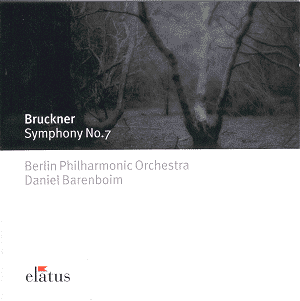Daniel
Barenboim is a man and a musician for whom I have the greatest
admiration and respect – in particular his brave contributions
to Arab-Israeli relations. He undoubtedly loves to provoke a reaction
or a viewpoint, whether to his political activities or to his
interpretations of the music he plays and conducts. It’s very
difficult to be indifferent to the way he shapes his performances,
and his powerful personality often makes you accept an approach
you may not fundamentally sympathise with.
Barenboim’s
liking for slow, broad tempi, and his search for extreme flexibility
has led to his often being compared to Furtwängler, a conductor
he certainly admires deeply. At his best, Barenboim does not automatically
select the slowest possible speed; rather he stretches
the scale of possible tempi, studiously avoiding the middle ground,
the ‘comfortable’ speed for players and listeners. This approach
has its severe risks, though. I remember a Barenboim performance
of the Choral Symphony where, at the crucial first presentation
of the ‘Ode to Joy’ theme, the double-basses set of at double
speed, unable to believe the conductor’s extreme slowness. Ruined
the entire concept of the performance.
What
of this Bruckner 7? The opening is marked "Allegro moderato,
58 minims to the minute." What is crucial to a musician
in these quite specific instructions from the composer is the
fact that he has chosen the minim as his reference point,
suggesting an underlying pulse of two beats in the bar.
Barenboim actually starts a little slower than this, not much,
but by the fifth bar of the wonderful theme, presented first by
‘cellos and horns, he has slowed down to little more than two-thirds
of that speed. This tendency – to start broadly, but then get
even slower – is manifest all the way through the piece.
There are several lengthy melodies, and in each case, Barenboim
robs them of their natural sense of growth and phrasing by allowing
them to sag.
Of
course, this is done in the name of expressive intensity, and
the Berlin Philharmonic do respond sensitively, as you would expect.
But overall, it means that the performance lacks momentum, and
in Bruckner, that is serious. For me, this shortcoming undermines
Barenboim’s reading, and leaves us with an interpretation of the
total work which, despite its loving insights into many details,
lacks cumulative power. If you compare the great first movement
to, for example, Klemperer’s account with the Philharmonia on
EMI, you find that the older conductor keeps the movement moving
along, so that the overall effect is satisfying, as of a single
line pursued to its natural conclusion.
If
you think I’m being unfair, try listening to the beginning of
the Adagio, and see if you can feel a pulse of any kind
– I confess I couldn’t, and again, the movement seems to hang
fire, to lack forward motion. The remaining two movements are
better, the scherzo building powerfully, with a real rhythmic
surge, and the finale lively and eventful. Somehow, though, that
sense of exaltation and completeness remains elusive, and the
final climax is not wholly convincing.
The
sound is good, but lacking in a certain immediacy. It’s a well
integrated picture, but lacking in brilliance, the thunderous
tuttis rather tame. I have to reiterate that the BPO’s playing
is very fine, but ultimately this recording is not for me – Barenboim
is not as successful in this work as a number of conductors, in
particular Klemperer as mentioned above, and Günter Wand
on RCA.
Gwyn
Parry-Jones
